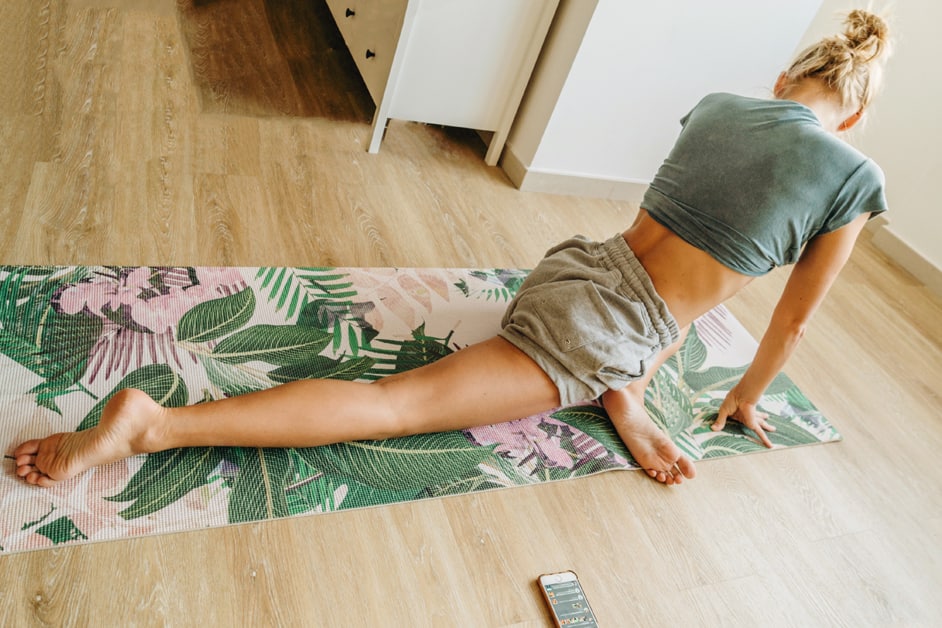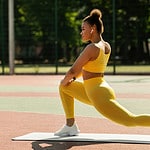Introduction
Knee cartilage damage can be painful and cause disability if not managed. Practicing certain Yoga poses can assist in stretching and strengthening the knee muscles and tendons, which can help to reduce the pain. In this article, we’ll examine five Yoga poses especially good for treating knee cartilage damage:
Overview of knee cartilage damage
Knee cartilage damage, otherwise known as chondromalacia, is a condition caused by wear and tear of the surfaces between the thigh and lower leg bones in the knee joint. This can bring on pain when climbing/descending stairs, running, jumping, or squatting. A clicking sound or grating sensation may also be felt.
The reason for this condition is generally overuse, weak muscles in the hip and knees, or an injury. Treatment includes at-home care like rest and ice therapy. Physical therapy is also necessary to strengthen weak muscles around the joint. Additionally, a set of yoga poses can support healthy knee cartilage by working to build strength and flexibility within the joint.
Pigeon Pose
The Pigeon Pose is ideal for those with damaged knee cartilage. It stretches the hips, groin, and thighs, increasing circulation to the affected area. This helps with healing and reduces pain. Strengthening the lower body muscles, such as the hips and thighs, is important for proper knee alignment.
So, how do you do the Pigeon Pose?
Benefits
Pigeon Pose is an amazing yoga asana! It offers a lot of physical and mental benefits. You can use it to manage knee cartilage damage, or even as a warm-up.
Physically, it increases flexibility in the hip joint. Also, it opens muscles in the inner thighs, glutes, and lower back. With regular practice, it even improves core strength. It’s also great for headaches and sciatica pain.
Mentally, it helps reduce stress. With a focus on breath, it can create moments of deep meditation. This helps the body turn inward, away from distractions. Resulting in enhanced mental focus and balance.
Step-by-step instructions
Pigeon pose is a hip opener and helps to reduce stress on the knees. It promotes proper alignment and is good for those with cartilage damage. Follow these steps to practice Pigeon pose:
- Begin in a tabletop position on all fours. Bring your right foot up behind the right hand, close to the right elbow. Point your toes downwards towards your left thigh.
- Square off both hips and draw your left shoulder in slightly. Keep both legs externally rotated so they face downwards towards the mat. Notice tension and take 5 breaths before releasing. Switch sides for even distribution.
- Slowly deepen into Pigeon. Bend at the tops of both thighs and fold over your front thigh bones. Respectfully set boundaries between yourself and a pain-free range of movement.
- Edge into Pigeon further by lightly propping under each shin or forehead resting onto either bent leg, if desired. Maintain correct alignment. Stay in this position up to 90 seconds while breathing naturally. Release back down and relax arms onto the mat. Switch sides and exhale on completion.
Reclined Hand-to-Big-Toe Pose
The Reclined Hand-to-Big-Toe Pose is great for those with knee cartilage damage. It strengthens the knee joint and stretches it, decreasing pain. Also, it helps the body relax and improves circulation to the knee. Let’s take a look at how you do it:
Benefits
Reclined Hand-to-Big-Toe Pose (Supta Padangusthasana) is a restorative yoga pose that strengthens legs and hips. It gives a great stretch to the hamstrings and quadriceps, along with glutes. Moreover, it helps ease out ankles, hips, shoulders & other parts. Regular practice of this pose may reduce knee cartilage damage by building strength in the knees and muscles around.
Benefits of Reclined Hand-to-Big Toe Pose are:
- Improved stability in hips
- Increased flexibility in legs
- Knee pain reduction
- Strengthened spine & improved posture
- Enhanced blood flow to relieve stress
- Decreased risk of knee injury from overuse or repetitive motions.
Step-by-step instructions
Reclined Hand-to-Big-Toe Pose, also known as Supta Padangustasana, is great for knee cartilage health. It keeps the knee flexible and strengthens the muscles around the joint. To get the best out of this pose, follow these steps:
- Lie on your back with legs straight. Bend one knee, reach inside of the foot with both hands, and hold onto the big toe if possible.
- If it’s too hard, use a strap looped around the ball of your foot.
- Roll onto one hip, flex and externally rotate the lifted leg towards the opposite side, parallel or slightly lower than the mat.
- Keep both sitting bones up as you bring one arm out and stretch for five breaths. Switch legs, move slowly and with awareness. When finished, relax in Child’s Pose or any variation till all tension is gone.
Do this regularly, getting checked by a medical practitioner throughout the entire time, for quick healing and reaching your final goal!
Half-Bound Lotus Pose
The Half-Bound Lotus Pose – or Ardha Baddha Padmottanasana – is a great yoga pose if you’re looking to heal a knee cartilage injury. It opens up your hips, hip flexors, and hamstrings, reducing knee pain. Plus, it strengthens your knee joints, increases flexibility, and reduces cartilage damage.
Here’s how to do it right:
Benefits
Half-Bound Lotus Pose, or Ardha Baddha Padmottanasana, is a pose that can help knee mobility and reduce pain from cartilage damage.
It strengthens the muscles around the knees, including adductors, gastrocnemius, soleus and other muscles. It also lengthens the spine, stretching tight muscles in the hips, lower back and glutes. It stimulates circulation and calms the mind.
The pose can be adjusted to suit individual needs, depending on the injury or diagnosis. Always consult a doctor or physical therapist before attempting this pose if there are any existing conditions.
Step-by-step instructions
Half-bound Lotus Pose (Ardha Baddha Padmottanasana) is a beneficial pose. It helps repair cartilage and reduce inflammation and knee strain. It helps build up strength in the muscles around it. Here’s how to practice it safely:
- Start in Staff Pose (Dandasana).
- Bring the right foot up towards the hip. Bend the left knee and stack the left ankle above the right.
- Reach around with both hands. Loop the right arm over the thigh and press it onto the thigh as you do so. Place the left hand on top of the right shins or knee. Keep an inward facing downward gaze.
- On each inhalation, press down into the supporting foot. Feel energy up through the core of both legs until the thighs are parallel. On each exhalation, draw the top of the hip bones towards the midline.
- Draw the upper inner thighs back and internally rotate the shoulders. Make sure the palms are pressed actively facing the earth’s surface.
- Rest for at least 5 breaths. Unwrap and slowly lift the toes off the floor. Hinge the torso forward from the hips. (Optional Ardha Uttanasana).
- To come out of the pose, lift the fingertips away from the floor. Untangle the wrapped leg. Bring the shoulder blades together and descend the hips down onto the mat in bridge position.
- Activate the Bandhas and relax into Shivasana.
Reclined Cow Face Pose
Get ready for the Reclined Cow Face Pose! This pose—known as Supta Gomukhasana—is super beneficial for knee cartilage damage. It stretches and strengthens your hips, groin, and thighs. Plus, it relieves knee pain and boosts joint mobility. You can do this pose while seated or reclined.
Here’s what else you should know about the benefits of Reclined Cow Face Pose and how to practice it:
Benefits
Reclined Cow Face Pose (Supta Gomukhasana) is a gentle backbend hip opener. It can help mobilize tight hips and improve range of motion in the spine and legs. Plus, it soothes the mind.
This pose stretches the shoulders, calves, chest and sides of the body. It stimulates energy flow through the subtle body. Physically, it helps to open up tight hips and may provide some relief for lower back pain. It also strengthens the core muscles.
On an emotional level, Reclined Cow Face Pose provides grounding energy. It promotes relaxation and reduces tension from stress or emotional trauma held in the physical body. This calming pose increases self-awareness. It allows for inner healing processes to take place during practice.
Regular practice of Reclined Cow Face Pose may restore balance between emotional extremes such as anxiety or sadness without having to force it away.
Step-by-step instructions
Supta gomukhasana, or reclined cow face pose, is great for stretching and opening your hips, hip flexors, psoas muscle and iliopsoas. Those with knee cartilage damage can benefit, as it helps build strength while avoiding extra strain.
- Lie on your back with your feet together and arms at the sides.
- Bend both legs and stretch one out until it’s in line with the hip.
- Lift the bent leg off the floor and create a figure four shape with both.
- Now reach both arms over your head, unlocking the elbows. One arm should point up, the other towards your foot or ankle. Try to keep your hips grounded.
- Feel a gentle stretch in the lower back and inside of both legs.
- Hold for five breaths and then switch sides.
Reclined Spinal Twist
Reclined Spinal Twist is a gentle, restorative yoga pose. It is suitable for those with knee cartilage damage. It lengthens and stretches the spine, improves mobility and flexibility, and reduces lower back stress and tension. Practicing this pose can help ease pain due to cartilage damage and can also strengthen the knee muscles, preventing injury.
Benefits
The reclined spinal twist is a yoga pose with many benefits. It stretches and strengthens muscles and ligaments in the back, shoulders, hips, abdomen, and buttocks. It reduces stress and tension while increasing flexibility in the spine. It also improves circulation to the knee joint helping it repair faster.
It can relieve pain by creating alignment between hip joints, releasing pressure on the knee joint. This pose helps reduce inflammation in the knee joint and promotes cartilage healing, including:
- Creating alignment between hip joints.
- Releasing pressure on the knee joint.
- Reducing inflammation in the knee joint.
- Promoting cartilage healing.
Step-by-step instructions
The reclined spinal twist is a great yoga pose, for both beginners and advanced yogis. It helps stretch the spine, increase flexibility and reduce stress. Follow these steps for a full spinal twist:
- Lie on your back. Stretch your legs out and relax your arms at your sides, with palms facing up. Make sure you’re comfortable and have a neutral spine.
- Bring one leg up towards your chest. Keep the knee bent at 90 degrees and make sure your ankles stay aligned.
- Let the bent knee fall gently to one side while exhaling out through your mouth. You should feel a gentle stretching sensation along the muscles of your spine. Keep a neutral pelvis throughout the movement.
- Hold the pose for 3-5 breaths. Then, slowly release back into starting position. Repeat the same process on the other side, if desired.
Conclusion
When your knee joint’s cartilage is damaged from illness or injury, yoga can help with recovery. This guide discussed five postures to rebuild strength and protect the knee. If you make it part of your routine, you’ll reduce discomfort, improve joint health, and increase flexibility – without putting strain on the damaged area.
Focus on strengthening opposing muscles for:
- Hip openers
- Kneeling postures
- Pushing poses
- Standing poses
- Hip extenders
You’ll make progress with patience, so go slowly as you create a yoga practice to reduce cartilage damage in your knee.
Frequently Asked Questions
Q1: What causes knee cartilage damage?
A1: The primary cause of knee cartilage damage is osteoarthritis. Other causes include sports injuries, traumatic injuries, and repetitive stress.
Q2: How can yoga help with knee cartilage damage?
A2: Practicing certain yoga poses can help strengthen the muscles around the knee joint and improve flexibility, which can help reduce pain and improve the overall health of the cartilage.
Q3: What are some yoga poses that can help with knee cartilage damage?
A3: Some yoga poses that can help with knee cartilage damage include the Warrior I and II poses, Chair pose, Triangle pose, and Half Moon pose.





